In a vibrant brush with ‘Sunday in the Park,’ Chicago Shakespeare connects all the dots
 Review: “Sunday in the Park with George” by Stephen Sondheim and James Lapine, directed by Gary Griffin, at Chicago Shakespeare Theater through Nov. 11. ★★★★★
Review: “Sunday in the Park with George” by Stephen Sondheim and James Lapine, directed by Gary Griffin, at Chicago Shakespeare Theater through Nov. 11. ★★★★★
By Nancy Malitz
“Sunday in the Park with George” was one of the first musicals I saw live on the New York stage, and although one’s memory isn’t much more than fantasy at such a distance, I recall the questions in the air back then, in 1984. Was Stephen Sondheim at his peak or over it? Wasn’t Bernadette Peters over-the-top fabulous, though? And was that sarcastic, defensive artist called George in the second act really Sondheim himself, yelling at us, venting his rage at being stuck, and blaming the riff-raff for his pain?
But that was back in a time when having your music compared to Stravinsky could still be considered an insult.
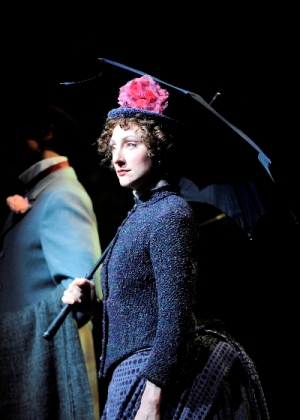 Today, both Stravinsky and Sondheim are pretty much universally beloved — their music even hummed! — in direct contradiction to the old complaint that both wrote impossibly clever densities of disconnected dots.
Today, both Stravinsky and Sondheim are pretty much universally beloved — their music even hummed! — in direct contradiction to the old complaint that both wrote impossibly clever densities of disconnected dots.
Sondheim, it turned out, had not passed his peak. “Sunday in the Park with George” survived snubs by the Tonys and changes of cast, and it came to mark the beginning of an important new phase of collaboration with the young writer-director James Lapine. And “Sunday’s” second act, at least as it is now being offered by director Gary Griffin and the pitch-perfect artistic and acting ensemble at Chicago Shakespeare Theater, isn’t about Sondheim ranting after all. It’s about all of us. And it sears. And it’s smart.
The quintessential experience of autumn 2012 in Chicago, for visitors and locals alike, has got to be the pairing of a visit to the Art Institute of Chicago to see Georges Seurat’s grand assemblage of dots — “A Sunday Afternoon on the Island of La Grande Jatte” — with a ticket to a live performance of the Stephen Sondheim and James Lapine musical “Sunday in the Park with George” at Chicago Shakespeare, starring Carmen Cusack as a singular Dot.
 Cusack plays the neglected model and lover of the fictionalized pointillist painter George, who loses sight of this one Dot among the many as he enters the world he’s painting. “Sunday in the Park with George” imagines Seurat’s struggle to create the masterpiece he’s remembered by. What Lapine and Sondheim make manifest is that if you’re trying to inhabit the imagination of a great artist, it pays to be one yourself.
Cusack plays the neglected model and lover of the fictionalized pointillist painter George, who loses sight of this one Dot among the many as he enters the world he’s painting. “Sunday in the Park with George” imagines Seurat’s struggle to create the masterpiece he’s remembered by. What Lapine and Sondheim make manifest is that if you’re trying to inhabit the imagination of a great artist, it pays to be one yourself.
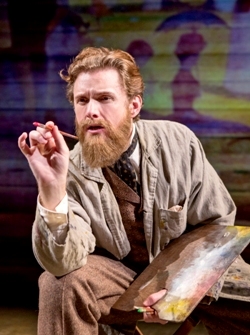 You will not leave this show wanting to trade your life for George’s. But it sure is a thrill to ride that hot streak with him, as interpreted by the agile tenor Jason Danieley, who makes perfect clarity of George’s painterly streams of consciousness.
You will not leave this show wanting to trade your life for George’s. But it sure is a thrill to ride that hot streak with him, as interpreted by the agile tenor Jason Danieley, who makes perfect clarity of George’s painterly streams of consciousness.
In the first act sequence “Color and Light,” George brings people and hats and dogs and trees to life with wrist-numbing jabs of the paintbrush that match his pointillistic patter. He applies dots of red, more red, a little more red, and “blue blue blue blue.”
It’s a virtuosic litany peppered with swigs of beer and the occasional stuttering jabs of resentment over the needy human Dot, who tends to sneak in on thoughts di-ag-ag-ag-ag-ag-o-nal-nal, when all George wants to do is “finish the hat finish the hat / Have to finish the hat first / Hat hat hat hat ….”
 “Sunday in the Park with George” is a dazzling, if intimate, portrait of what it means to be in the precious zone of creativity, and then to be bereft of it. It’s well suited to the near surroundings of Chicago Shakespeare’s thrust stage and its clear but resonant acoustic space.
“Sunday in the Park with George” is a dazzling, if intimate, portrait of what it means to be in the precious zone of creativity, and then to be bereft of it. It’s well suited to the near surroundings of Chicago Shakespeare’s thrust stage and its clear but resonant acoustic space.
The musical preparation and direction of Brad Haak reflects a deep love of Sondheim’s score and the certain knowledge that in a musical, the characterization begins with the music. The concept of director Griffin, set designer Kevin Depinet and projection artist Mike Tutaj is to keep awareness of the genius painting ever present, and even as the actors work well into the room on its extending stage, there’s that hovering reminder of the actual masterpiece whose gestation is being imagined.
The show’s second half, a fictonalized flash-forward to another artist named George who just might be Seurat’s great-grandson, is strengthened by this treatment, which lays the pressure on.
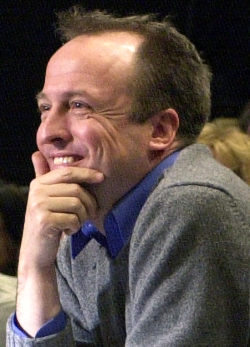 Griffin’s own directorial choices throughout are marked by a gentle hand and acute sensitivity to the music. His insights feel like underscoring; they do not seem imposed. The use of a double set of white picture frames — one around “La Grande Jatte” and another to swoop down, zero in, crop focus and direct attention — allows for elegant scene changes.
Griffin’s own directorial choices throughout are marked by a gentle hand and acute sensitivity to the music. His insights feel like underscoring; they do not seem imposed. The use of a double set of white picture frames — one around “La Grande Jatte” and another to swoop down, zero in, crop focus and direct attention — allows for elegant scene changes.
An impressive assembly of actors, including some Chicago familiars, bring the many characters in Seurat’s painting to life, including Linda Stephens as the Old Lady, Ora Jones as her unflappable nurse and Benjamin Magnuson as the stiff-legged, acid-tongued boatman. Sean Fortunato plays George’s artistic friend and gadfly in both centuries.
Cusack’s Dot is funny, warm and ultimately wise without being brilliant about art itself. Dot knows her lover is good at what he does, but she’s more obsessed, as people tend to be around artists, by what he isn’t. Cusack the artist, by contrast, is the real thing, capable of bringing the utmost intensity and delicacy to life with her voice, a virtuosity mirrored in her face and action. She’s the definitive Dot for a new century.
Cusack and Danieley are quite touching together as the 19th-century couple who must split, and they constitute as credible a pair as I have even seen in the second act, where Cusack plays the role of Marie, the 98-year-old grandmother to Seurat’s namesake and probable descendant. Their latter-day scene, which is largely Marie’s frail song “Children and Art,” is devastating. She drifts in and out of reality, and in her hallucinatory state she touches a few very raw nerves in George, who suspects he has played out his creative string.
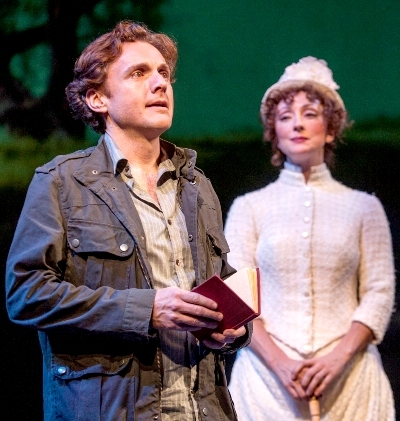 Everything that comes after “Children and Art,” as the musical winds towards its end, is illuminated by George’s panic and uncertainty, and by the way this production wraps his crisis in a wider human embrace. It’s a credit to Griffin how the director enlarges the psychological frame.
Everything that comes after “Children and Art,” as the musical winds towards its end, is illuminated by George’s panic and uncertainty, and by the way this production wraps his crisis in a wider human embrace. It’s a credit to Griffin how the director enlarges the psychological frame.
When they sing together again, Cusack and Danieley are in another time and place; she has become the white-clad ghost of Dot and the location is the very Paris island that Seurat made famous. The young George has come here in desperation. As the entire cast reassembles in white versions of their attire in Seurat’s tableau — a splendid visual cue of the ancestral spirits George has summoned to help him make the only choice he can fruitfully make – Sondheim’s musical threads from earlier scenes emerge, and the delivery of the show’s last song achieves its proper brutal radiance.
Related Links:
- Performance location, dates and times: Details at TheatreInChicago.com
- Explore the process by which Seurat created his masterwork: Briefing at artic.edu
- Video of the original production, adapted for TV: Find it at Amazon.com
- In Sondheim’s words: See the lyrics come together in “Look, I Made a Hat”
- Zero in on those dots: Hit the plus button on the Art Institute’s explorer page
Captions and Credits: Homepage and top: George (Jason Danieley) finishes the hat in a pointillistic frenzy of painting in Stephen Sondheim’s “Sunday in the Park with George” at Chicago Shakespeare Theater. (Photo by Liz Lauren) Descending: George’s model and mistress Dot (Carmen Cusack) struggles with the pain and boredom of maintaining her pose. (Photo by Liz Lauren) The painting that inspired the musical, ‘Un dimanche après-midi à l’Île de la Grande Jatte – 1884’ by Georges Seurat, is on display just beyond the top of the grand staircase at the Art Institute of Chicago. (Image via Wiki Creative Commons) George’s rapid patter stream-of-consciousness song, as he gets lost in his work, is a first act highlight sung by Jason Danieley. (Photo by Liz Lauren) Composer-lyricist Stephen Sondheim. (Photo ©ArenaPal/TopFoto/The Image Works, via Chicago Shakespeare Theater) Chicago Shakespeare Theater associate artistic director Gary Griffin. (Photo by William Burlingham) George, the namesake and probable great-grandson of the great 19th-century artist, is visited by the ghost of Dot as he reads from her primer. (Photo by Liz Lauren) Below: George (Jason Danieley) and Dot (Carmen Cusack) with some of the cast members who bring figures in Seurat’s painting to life. (Photo by Liz Lauren) A cool tool allows you to click anywhere on the image and find out what dots are contributing to the color. (Art Institute website) Video of a visit by the cast of Chicago Shakespeare Theater’s “Sunday in the Park with George” to the Art Institute of Chicago, home of the Seurat masterpiece. (YouTube)
Tags: "Sunday in the Park with George", Benjamin Magnuson, Brad Haak, Carmen Cusack, Derek Hasenstab, Elizabeth Lanza, Gary Griffin, Jason Danieley, Keidi Kettenring, Kevin Depinet, Kevin Gudahl, Linda Stephens, Madison Olszewski, McKinley Carter, Michael Aaron Lindner, Mike Titaj, Ora Jones, Philip S. Rosenberg, Rachel Cantor, Ryan T. Nelson, Sean Fortunato, Stephen Sondheim, Travis Taylor

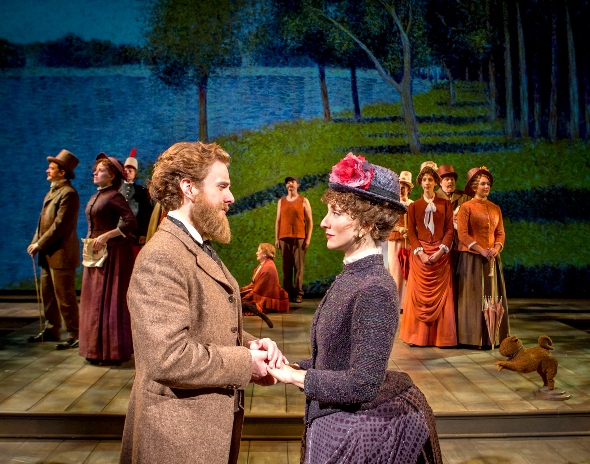
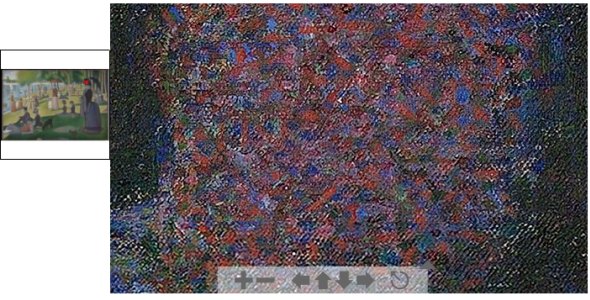

No Comment »
2 Pingbacks »
[…] Sondheim’s “Sunday in the Park with George”: Chicago Shakespeare connects all the dots […]
[…] Sondheim’s “Sunday in the Park with George”: Chicago Shakespeare connects all the dots […]